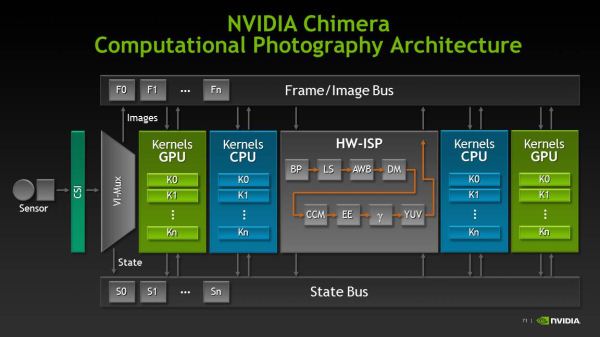NVIDIA Tegra 4 Architecture Deep Dive, Plus Tegra 4i, Icera i500 & Phoenix Hands On
by Anand Lal Shimpi & Brian Klug on February 24, 2013 3:00 PM ESTNVIDIA has upped its ISP game with Tegra 4, and includes the same ISP in both Tegra 4 and 4i, which they’ve dubbed Chimera. This new ISP includes a number of features which were already demonstrated at CES, but NVIDIA went into greater detail.
NVIDIA’s major new feature with Tegra 4 is inclusion of new APIs which leverage the GPU to enable computational camera features In addition to the traditional ISP pipeline. To begin, NVIDIA has made their own enhancements in the imaging chain which leverage this GPU-assisted architecture that sits atop the normal ISP. They’ve outlined a few features which work atop this — HDR panorama, HDR stills, and real time object tracking. The end result is that Chimera is one part programming model and APIs for future development efforts by third parties, another part first party software that NVIDIA will distribute for integration in OEM cameras which includes the HDR features and object tracking.
Chimera allows developers to build blocks around the traditional ISP data flow and get to manipulate either bayer image data or YUV space image data on the CPU or GPU using their own framework. There are still a lot of details to come about the programming model and how this will be exploited, but there clearly is space here for NVIDIA to try and make a case for their GPU being useful for image processing. At the same time, the elephant in the room is OpenCL (and its current absence on Tegra 4) and what direction the industry will take that to leverage GPU compute for some computational photography processing.
The novel new feature of note is something I was skeptical about upon seeing at CES — single frame HDR video. The traditional route for HDR video capture is to capture at twice the framerate of the intended output video, for example for 720p30 video with a two-frame HDR, that would mean capture at 720p60 with two different exposures. What NVIDIA does is a bit different. Instead of capturing two exposures and combining them after capture, NVIDIA has found a way to drive selected CMOS sensors (both IMX135 from Sony and AR0833 from Aptina have been called out specifically, but there are more) in some special fashion, and recombine interleaved high and low exposure images (the +1 stop, –1 stop) image into one equivalent frame. This is all done on the GPU using the same Chimera pipeline blocks, but with NVIDIA’s own algorithm. The results are actually pretty impressive, NVIDIA claims 3 stops of dynamic range (~24 dB), and no recombination artifacts.
Previous demonstrations of HDR video capture on a few other platform have had halos around moving elements because of the issues associated with taking two temporally different frames and recombining them. With NVIDIA’s HDR video capture I saw no halos even on very fast moving objects, with the same quality of HDR.
NVIDIA also demonstrated their panorama capture which includes HDR as well, using a GigaPan Epic 100. Admittedly a better demo might be hand held to demonstrate how well the ISP is able to compensate for change in perspective from the tablet moving around in the hand, the resulting image was the same quality of HDR as the still however. I also saw object tracking which essentially is face tracking (and thus AE / AF assist to that subject) but taken to arbitrary subjects. Paint a box around the object you want to track, and the camera will perform feature extraction and machine learn a model around the object. Rotating around complex geometries seemed to work decently well — the model learns slowly so slow movements can be accommodated, faster moving subjects might not be object tracked.
I also got a chance to tour NVIDIA’s camera tuning labs, where they characterize smartphone CMOSes for handset markers, and work with them on tuning their ISP and imaging experience. I saw one calibration room with many different scenes, and then another room with large test charts, and two sets of standard test scenes in lightboxes. The ever-familiar GMB color checker card and ISO12233 charts were everywhere as well.
















75 Comments
View All Comments
darkich - Monday, February 25, 2013 - link
You should know better than to compare different platforms on sunspider.It's more software than hardware dependant benchmark.
Read the jefkibuule's post
danielfranklin - Wednesday, February 27, 2013 - link
With my own testing ive managed to get my Nexus 10 at between 500-600ms on Sunspider. Clocked at roughly 2ghz. It depends more on the browser, the stock android browser is much faster at this than Chrome and doesnt come with the Nexus 10 or Nexus 4.ilihijan - Sunday, March 3, 2013 - link
I just got paid $6784 working on my laptop using these simple steps leaked on this web page. Make up to $85 per hour doing simple tasks that are so easy to do that you won't forgive yourself if you don't check it out! Weekly payments! Here is what I've been doing Epic2.c(om)GiantPandaMan - Sunday, February 24, 2013 - link
Given the vastly different conclusions and what not, I think it would be interesting if Charlie and Anand had a roundtable discussion about the SoC space, both phone and tablet. Has Tegra had a noticeable lack of design wins? Has nVidia overpromised and underdelivered three times in a row? Or is Charlie exaggerating far too much?I'm making no judgement myself, since I really know very little about how phone and tablet manufacturers view the various SoC's.
Have you guys reached out to manufacturers and gotten their takes at all?
s44 - Sunday, February 24, 2013 - link
What, Charlie pushing anti-Nvidia storylines? Who'd have imagined that.lmcd - Sunday, February 24, 2013 - link
I feel like T2 underperformed because the software on it underperformed (see DX2), as Honeycomb was a pretty terrible release.Tegra 3 didn't do poorly at all. It performed phenomenally as a cheap chip (though the high-clocked ones on high-end phones made no sense). 28nm was a must-have for a high-end chip that generation.
Tegra 4 looks about where everyone expected it. No one should have been surprised with any of those units on the performance levels.
lmcd - Sunday, February 24, 2013 - link
DX2 and Honeycomb not being the same subject of course.But 2.3 was equally bad
rahvin - Monday, February 25, 2013 - link
A lot of what Charlie said is easily check-able. Tegra2 had a ton of design wins and almost no actual sales. Tegra3 has done phenomenally, but only in tablets and it's already been replaced in one or two. I think the most prophetic thing he said is the most obvious, unlike every previous generation they didn't announce a single design win for Tegra4. That to me speaks volumes.We'll know in time if it's just the vendetta or if his sources are correct. I've never heard of a chip maker doing a reference design and personally I just don't see that having any effect or why they would even do it. The manufacturers like to differentiate and the reference design takes that away, which again speaks to lack of manufacturer interest. Charlie tends to over exaggerate things but IMO he's been fairly spot on. Even with the highest revenue in their history profit was down almost 25% (which I attribute to the change to paying for wafer instead of good chips).
Again, time will tell.
Kidster3001 - Thursday, February 28, 2013 - link
FFRD is popular for companies that only produce the chips and not any phones themselves. Samsung has no need to do it, Apple either. Who's left? Qualcomm sells (almost) reference designs with their MDP, Intel's first two phones (Lava Xolo and Orange Santa Clara) were basically rebadged reference devices. Now NVidia's doing it. One advantage to having an FFRD is so that the customer can bring it to market faster and cheaper. OEM's like that and it also allows for chip manufacturers to get their stuff into the hands of smaller OEMs who don't have large R&D budgets.All the Tegra chips have had higher power consumption than their peers from other manufacturers. It looks like Tegra4 is no exception. They work well in tablets where it is less important, but poor battery life is a really good reason for OEM's to not make phones based on your chips.
My personal opinion is that A15 (ARMs core) will never be a really good design for a phone. It has really high performance but the power envelope just isn't going to work. Those who design custom cores will come out ahead in the phone battle: Apple, Qualcomm, Intel and perhaps even NVidia if they move away from ARM IP with their Denver design.
TheJian - Monday, February 25, 2013 - link
Charlie has hated NV forever. He did the same crap at theINQ for years. At least he named his site accurately...ROFL. Actually I enjoy reading (used to) some of his stuff, but when he speaks about NV I'd say his site should have been named usuallynotaccurate.comNow he's actually charging for semiaccurate articles...LOL
Seriously? If it was that important I'd rather pay for something like MPR. Charlie is usually good for a laugh and that's about it regarding NV.
Though I've written some stuff about this site's bias recently (my titan article posts and the 660ti article comments), I don't think anandtech and semiaccurate sit at the same table. Anandtech isn't making stuff up, they're just leaving out 3/4 of the story IMHO (regarding my comments on the 14games etc that should be in the game suite & the two that shouldn't). Charlie just throws darts at a board for a large portion of his articles. IF you keep his articles (I did for a long time) and go back over them he's only right about 50%. Either he's getting WMD like UK info (ala bush and iraq, though I think they just moved them to syria...LOL we gave them ages to move them) or he just makes it up himself ("my deep mole in x company said blah blah"). There's no proof until ages later when most forget what he even said, right or wrong. Note there is NO COMMENT section on the site now. They're all blocked :) Ubergizmo called his site "half accurate". My data of old articles used to say the same :) I expect more than flipping a coin results in reporting. He gets credit for things like breaking the news on the bapco fiasco, but I'd say Van Smith gets credit for exposing not only that Intel OWNED the land they had their building on (they paid rent to Intel), Intel OWNED their domain name, and even had a hand in WRITING the code as Intel software engineers were on hand next door. Van covered it all YEARS before Charlie. Look up Van smith and vanshardware, a lot of that crap and the biased intel reporting forced Van to leave and probably dropped the price of Toms site to 1/4 of it's value when tom dumped it. He was worth MORE than anandtech before that stuff. Not sure of the value today, I'm talking back then.
Biased reporting gets you killed if the right people keep pointing it out with DATA backing it. IF Tom's hadn't gone down that Intel love-in route he probably could have sold for much more. There's a reason Otellini said in 2006 that toms was his favorite tech site ;) Then in turn dumped the site as it's credibility tanked. Bapco was, and still is a sham. AMD/NV/VIA all left the consortium for a reason. I don't put much stock in anything from them (futuremark either). Tom's treatment of Van (even removed his bylines on stories) was downright disgusting. I stopped reading toms for about 5 years due to that crap in ~2001. He replaced every article the guy wrote with "THG staff". Total BS. Charlie does the same with NV hate as toms with Intel love. This crap costs credibility.
Anandtech is coming close to the same thing on NV gpu's; Ryan's AMD love anyway, I'll bang away until he stops :) Funny how they never attack the data I provide here. I link to them at toms forums too, eventually that will begin to hurt as people look at the evidence and draw their own conclusions about his articles and in turn this site's credibility. If he continues on the next reviews (700's and 8000's) I'll get on a lot more forums linking the comments after the data dismantling (polite critique of course Ryan :)).
The "Jian" is a double edged sword Ryan ;) Thin, light and very maneuverable...LOL
https://en.wikipedia.org/wiki/Jian
In Chinese folklore, it is known as "The Gentleman of Weapons"
I'm not hostile Ryan ;) Wikipedia says so. :)
Google this: thejian anandtech
Data piles up don't it? I save all my posts (before posting) anyway, but google does too.